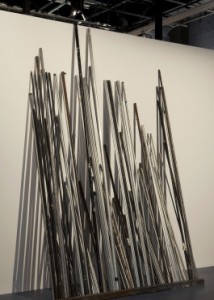
Virginia Overton’s habit of using unexpected objects to challenge our experiences of a particular space would seem well suited to the Kitchen. Yet the five sculptures she presents in this exhibit—made from steel pipes, two-by-fours, pedestals and other items collected behind the scenes at this venerable nonprofit—don’t greatly alter our sense of the institution, though they do reflect on the relevance of Minimalism today.
In the past, Overton’s sculptures have sometimes involved startling incongruences, but the pieces here—like a collection of well-used rigging poles propped against the wall and lit to create an elegant installation—look more attractive than out of place. Others carry on a more overt conversation with 1960s Minimalist art, such as the strongly spotlit, diagonally wall-mounted steel bar that recalls a Flavin fluorescent tube, or the floor-bound array of creaky two-by-fours that noisily raise one’s awareness of his or her footsteps, à la Carl Andre.
These two pieces and others touch on Minimalism’s penchant for interacting with or altering the exhibition space, but Overton ostensibly wants to elicit a deeper understanding of the venue’s identity (in this case, as a gallery and a theater). By quoting Minimalist aesthetics, she brings to mind concerns with light, space and viewer participation, all topics clearly relevant to the Kitchen’s history as a performance center. Considering the highly experimental nature of that history, however, Overton could have taken more risks, instead of just settling for tasteful arrangements.